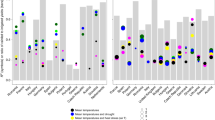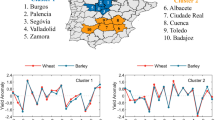Abstract
Trends in agro-climatic resources and wheat yields in the main grain regions of European Russia are considered. The analysis is based on the results of calculations performed with the Climate–Soil–Yield simulation system. The results reveal a relative decline in climate-driven yields of 10 to 30% over two decades for both winter and spring wheat. Multiple regression equations linking yield trends with indicators characterizing the state of agro-climatic resources are determined. They show differences in climate driven yield trends between spring and winter wheat. However, differences are only marginally significant suggesting that switching from spring wheat varieties to winter wheat would not completely neutralize the negative impact of climate trends. The probability of occurrence of drought in the grain regions of the European part of Russia is calculated for 1998–2017. The areas where the probability of occurrence of severe droughts during May–August equals or exceeds 50% are determined.






Similar content being viewed by others
REFERENCES
A. I. Budagovsky, Evaporation of Soil Moisture (Nauka, Moscow, 1964) [in Russian].
R. M. Vilfand, A. I. Strashnaya, and O. V. Bereza, “On the Dynamics of Agroclimatic Indicators of the Conditions of Sowing, Wintering and Crop Formation of the Main Crops,” Trudy Gidromettsentra Rossii, No. 360 (2016) [in Russian].
The Second Assessment Report of Roshydromet on Climate Changes and Their Consequences on the Territory of the Russian Federation (Roshydromet, Moscow, 2014) [in Russian].
G. V. Gruza and E. Ya. Rankova, Observed and Expected Climate Changes over Russia: Surface Air Temperature (WNIIGMI-MTsD, Obninsk, 2012) [in Russian].
Report on Climate Risks in the Russian Federation (Roshydromet, St. Petersburg, 2017) [in Russian].
A. N. Zolotokrylin, T. B. Titkova, and E. A. Cherenkova, “Humidification of Arid Lands of the European Territory of Russia: Present and Future,” Arid Ecosystems, No. 2, 20 (2014) [in Russian].
T. G. Nefedova, “Twenty-five Years of Russia Post-Soviet Agriculture: Geographical Trends and Contradictions,” Bull. Russ. Acad. Sci. Geogr. Series, No. 5 (2017) [in Russian].
V. N. Pavlova, “Analysis and Assessment of the Influence of Climatic Conditions of Recent Decades on the Productivity of Grain Crops in the Agricultural Zone of Russia,” Problemy Ekologicheskogo Monitoringa i Modelirovaniya Ekosystem, 23 (2010) [in Russian].
V. N. Pavlova, A Report on the Peculiarities of Climate on the Territory of the Russian Federation for the Year 2016, Section: Agro-climatic Conditions (Moscow, 2017) [in Russian].
V. N. Pavlova and A. A. Karachenkova, “Observed Climate Changes and Dynamics of Agro-climatic Resources in the 20th−21st Centuries on the Territory of the Volga Federal District,” Trudy GGO, No. 583 (2016) [in Russian].
V. N. Pavlova and O. D. Sirotenko, “Observed Climate Changes and Dynamics of Agricultural Productivity in Russia,” Trudy GGO, No. 565 (2012) [in Russian].
Yu. P. Perevedentsev, R. M. Vilfand, K. M. Shantalinsky, V. V. Guryanov, A. A. Nikolaev, and N. V. Ismagilov, “Monitoring and Forecasting of Climate Variability on the Territory of the Volga Federal District,” Trudy Gidromettsentra Rossii, No. 371 (2018) [in Russian].
Federal State Statistic Service (2016), http://www.gks.ru/wps/wcm/connect/rosstatmain/rosstat/ru/statistics/ente-rprise/economy.
O. D. Sirotenko, “The USSR Climate-Yield Simulation System,” Meteorol. Gidrol., No. 4 (1991) [Sov. Meteorol. Hydrol., No. 4 (1991)].
O. D. Sirotenko, Mathematical Modeling of Water-heat Regime and Productivity of Agroecosystems (Hydrometeoizdat, Leningrad, 1981) [in Russian].
O. D. Sirotenko, Methods of Climate Change Assessment for Agriculture and Land Use. Methodological Guide (Roshydromet, Moscow, 2007) [in Russian].
O. D. Sirotenko and V. N. Pavlova, Methods for Assessing the Impact of Climate Change on Agricultural Productivity, Chapter 5: Methods for Assessing the Effects of Climate Change on Physical and Biological Systems, Ed. by S. M. Semenov (Roshydromet, Moscow, 2012) [in Russian].
O. D. Sirotenko, V. N. Pavlova, and E. V. Abashina,Method of Assessment of Agro-climatic Conditions for Monitoring Changes in the Modern Climate on the Territory of the Russian Federation (2013), http://method.meteorf.ru. [in Russian].
A. I. Strashnaya, L. L. Tarasova, N. A. Bogomolova, T. A. Maksimenkova, and O. V. Bereza, “Forecasting of Grain and Leguminous Crops Yield in the Central Chernozem Regions on the Basis of Integration of Ground and Satellite Data,” Trudy Gidromettsentra Rossii, No. 353 (2015) [in Russian].
A. V. Frolov and A. I. Strashnaya, “About the Drought of 2010 and Its Impact on the Yield of Grain Crops,” in Analysis of Abnormal Weather Conditions in Russia in the Summer of 2010 (Triada LTD, Moscow, 2011) [in Russian].
E. A. Cherenkova, M. Yu. Bardin, and A. N. Zolotokrylin, “The Statistics of Precipitation and Droughts during Opposite Phases of the Quasi-Biennal Oscillation of Atmospheric Processes and Its Relation to the Yield in the European Territory of Russia,” Meteorol. Gidrol., No. 3 (2015) [Russ. Meteorol. Hydrol., No. 3, 40 (2015)].
D. I. Shashko, Agro-climaticZoning of the USSR (Kolos, Moscow, 1967) [in Russian].
I. M. Shkolnik, G. B. Pigoltsina, and S. V. Efimov, “Assessment of Possible Influence of Climate Change on Agro-climatic Conditions of Cotton and Spring Wheat Growing in Central Asia,” Trudy GGO, No. 580 (2016) [in Russian].
J. Alcamo, N. Dronin, M. Endejan, G. Golubev, and A. Kirilenko, “A New Assessment of Climate Change Impacts on Food Production Shortfalls and Water Availability in Russia,” Global Environ. Change,17 (2007).
N. Brisson, P. Gate, D. Gouache, G. Charmet, F.-X. Oury, and F. Huard, “Why Are Wheat Yields Stagnating in Europe? A Comprehensive Data Analysis for France,” Field Crops Res., 119 (2010).
FAO. Faostat FAOSTAT Data (Food and Agric. Org. United Nations, Rome, 2016), accessed 15 July 2017.
R. Finger, “Evidence of Slowing Yield Growth—the Example of Swiss Cereal Yields,” Food Policy, 35 (2010).
IPCC, 2013: Climate Change 2013. The Physical Science Basis. Contribution of Working Group I to the Fifth Assessment Report of the Intergovernmental Panel on Climate Change, Ed. by T. F. Stocker, D. Qin, G.-K. Plattner, M. Tignor, S. K. Allen, J. Boschung, A. Nauels, Y. Xia, V. Bex, and P. M. Midgley (Cambridge University Press, Cambridge, United Kingdom and New York, NY, USA, 2013).
C. Lazar and G. Genovese, Methodology of the MARS Crop Yield Forecasting System, Vol. 2: Agrometeorological Data Collection, Processing, and Analysis (European Communities, 2004).
R. Licker, C. J. Kucharik, T. Doré, M. J. Lindeman, and D. Makowski, “Climatic Impacts on Winter Wheat Yields in Picardy, France and Rostov, Russia: 1973–2010,” Agric. For. Meteorol.,176 (2013).
W. Liefert, “Comparative Advantage in Russian Agriculture,” Amer. J. Agricul. Econom., 84 (2002).
D. B. Lobell, W. Schlenker, and J. C. Roberts, Climate Trends and Global Crop Production since 1980 (Sciencexpress, 2011), http://www.sciencexpress.org/5 May 2011/.
V. Pavlova, I. Shkolnik, A. Pikaleva, S. Efimov, A. Carachenkova, and V. Kattsov, “Future Changes in Spring Wheat Yield in the European Russia as Inferred from a Large Ensemble of High-resolution Climate Projections,” Environ. Res. Lett. (2019), https://doi.org/10.1088/1748-9326/aaf8be.
P. Peltonen-Sainio, L. Jauhiainen, and I. P. Laurila, “Cereal Yield Trends in Northern European Conditions: Changes in Yield Potential and Its Realization,” Field Crops Res., 110 (2009).
D. K. Ray, N. Ramankutty, N. D. Mueller, P. C. West, and J. A. Foley, “Recent Patterns of Crop Yield Growth and Stagnation,” Nat. Commun., 3 (2012).
F. Schierhorn, M. Faramarzi, A. V. Prishchepov, F. Koch, and D. Muller, “Quantifying Yield Gaps in Wheat Production in Russia,” Environ. Res. Lett., 9 (2014).
O. D. Sirotenko, E. V. Abashina, and V. N. Pavlova, “Sensitivity of the Russian Agriculture in Climate, CO2 and Tropospheric Ozone Concentrations and Soil Fertility,” Climatic Change, 36 (1997).
USDA-FAS. Grain: World Markets and Trade (United States Department of Agriculture, Foreign Agricultural Service, 2016), http://www.fas.usda.gov, accessed 15 July 2017.
A. J. W. Wit, H. L. De Boogaard, and C. A. van Diepen, “Spatial Resolution of Precipitation and Radiation: The Effect on Regional Crop Yield Forecasts,” Agric. For. Meteorol., 135 (2005).
Funding
The study was funded by a grant from the Russian Science Foundation (project No. 16-17-00063).
Author information
Authors and Affiliations
Corresponding author
Additional information
Russian Text ©The Author(s), 2020, published in Meteorologiya i Gidrologiya, 2020, No. 1, pp. 78–94.
About this article
Cite this article
Pavlova, V.N., Calanca, P. & Karachenkova, A.A. Grain Crops Productivity in the European Part of Russia under Recent Climate Change. Russ. Meteorol. Hydrol. 45, 290–302 (2020). https://doi.org/10.3103/S106837392004010X
Received:
Revised:
Accepted:
Published:
Issue Date:
DOI: https://doi.org/10.3103/S106837392004010X




